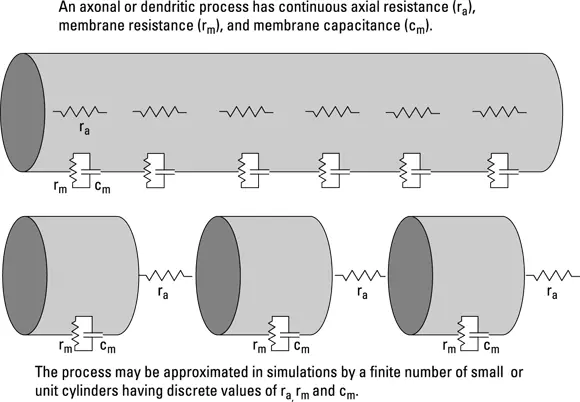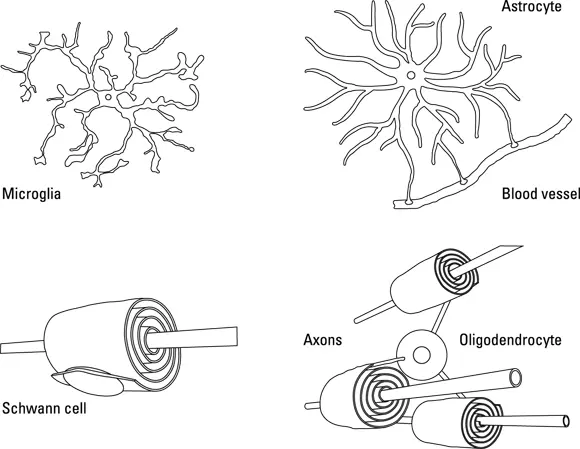The water pipe idea can also help us to understand membrane capacitance. Suppose the pipe is not a stiff metal one, but a very stretchy rubber hose. If you suddenly turn on the faucet, the water flow creates a bulge at the end of the hose near the faucet. The water travels down and creates another bulge, and so on, until water finally begins to leave the open end of the hose. Eventually, the flow out the end of the pipe will be equal to the flow into the pipe at the faucet. Membrane capacitance works in the same way, by delaying and soothing sharp inputs at one point on a dendrite while they’re on their way to other dendritic locations.
 The highly stretchable hose is like membrane capacitance. Even if the end of the hose — which you can think of as the energy storage mechanism — farthest from the faucet were closed, opening the faucet would allow some water flow until the force stretching the hose was exactly equal to the force where the water enters the faucet. This flow is always transient, however, just like the flow of current through a capacitor, which has a low resistance to changing voltage but blocks constant voltage.
The highly stretchable hose is like membrane capacitance. Even if the end of the hose — which you can think of as the energy storage mechanism — farthest from the faucet were closed, opening the faucet would allow some water flow until the force stretching the hose was exactly equal to the force where the water enters the faucet. This flow is always transient, however, just like the flow of current through a capacitor, which has a low resistance to changing voltage but blocks constant voltage.
The combination of low membrane resistance (holes in the pipe) and high membrane capacitance (stretchable pipe) means that synaptic input currents in one dendritic location may be severely weakened, delayed, and smoothed when they arrive at some other location. Figure 3-3 is a model that represents both continuous membrane resistance (due mostly to ion channels) and membrane capacitance.

Figure 3-3:Electrical model of the distributed membrane resistance and capacitance in a neural process such as a dendrite or axon. In thin processes, the axial resistance r acan become significant.
In real neurons, synaptic signals are so reduced over distances larger than about 200 micrometers that they become ineffective (low amplitude and slow time course). To communicate synaptic inputs over larger distances, neurons require active propagation, which I discuss in the next section.
Active propagation of depolarization
Most neurons have dendritic trees with diameters of less than a few hundred micrometers. This is the limit for passive signal propagation from the most distal dendrites to the soma. Larger neurons need to overcome the problems of weakened signals and signal smoothing if they are to communicate over distances larger than a few dendritic trees.
In the earlier section titled “Cable properties,” I mention that the analysis of dendritic signal propagation uses cable theory, derived from undersea telegraph cable technology. An undersea telegraph cable is a conductor such as a copper wire, insulated, and surrounded by seawater, which itself is conductive. This is like a neural process such as a dendrite immersed in conductive extracellular fluid (which, by the way, is somewhat similar in ionic composition to seawater).
 When testing began for the first undersea telegraph cables, it was found that signals (telegraph pulses) applied at one end were lost through the insulating layer and smeared out and delayed over time (due to the capacitance of the cable) when they were received some distance from the source. The solution for telegraph cables was placing repeaters along their length that boosted the signal back to its original strength before it was lost.
When testing began for the first undersea telegraph cables, it was found that signals (telegraph pulses) applied at one end were lost through the insulating layer and smeared out and delayed over time (due to the capacitance of the cable) when they were received some distance from the source. The solution for telegraph cables was placing repeaters along their length that boosted the signal back to its original strength before it was lost.
 Just like telegraph cables, neurons also use repeaters. Neuronal repeaters are the voltage-dependent sodium channels (we discuss them earlier in this chapter) working with the action potential. Voltage dependent-sodium channels cause further depolarization, which amplifies the depolarization signal in the membrane. This amplification in axons allows neurons to send pulses over arbitrarily long distances, exceeding meters.
Just like telegraph cables, neurons also use repeaters. Neuronal repeaters are the voltage-dependent sodium channels (we discuss them earlier in this chapter) working with the action potential. Voltage dependent-sodium channels cause further depolarization, which amplifies the depolarization signal in the membrane. This amplification in axons allows neurons to send pulses over arbitrarily long distances, exceeding meters.
The first long-distance neural signal amplification system to evolve was continuous in unmyelinated axons, with voltage-dependent sodium channels placed continuously.
 Neuroscience research is full of surprises. One from the last two decades is that neurons use signal amplification not only in their long axons, but also in their dendritic trees. This signal amplification can be done with either voltage-dependent sodium channels or voltage-dependent calcium channels, often located at branch points in the dendritic tree. These channels not only amplify, but also participate in the computing that takes place in the neuron’s dendritic tree. This is because the dendrite can use amplification to control the flow of information throughout the dendritic tree. The neuron’s dendritic tree can be divided into many subunits that interact and make complex processes — such as recognizing a particular pattern of action potentials on the dendritic tree — happen.
Neuroscience research is full of surprises. One from the last two decades is that neurons use signal amplification not only in their long axons, but also in their dendritic trees. This signal amplification can be done with either voltage-dependent sodium channels or voltage-dependent calcium channels, often located at branch points in the dendritic tree. These channels not only amplify, but also participate in the computing that takes place in the neuron’s dendritic tree. This is because the dendrite can use amplification to control the flow of information throughout the dendritic tree. The neuron’s dendritic tree can be divided into many subunits that interact and make complex processes — such as recognizing a particular pattern of action potentials on the dendritic tree — happen.
Insulating with Glial Cells
Many student neuroscientists are surprised when they learn that the most numerous cells in the nervous system are not neurons, but glia, which make up the nervous system’s connective tissues. In fact, glia outnumber neurons by about 10:1. Many types of glial cells with different functions exist (see Figure 3-4):
Astrocytes are glial cells that form part of the blood-brain barrier and regulate ionic concentrations of extracellular fluid.
Microglia scavenge for and clean up extracellular debris from dead cells and injury.
Schwann cells and oligodendrocytes wrap axons to enhance signal propagation. (See the next paragraph for more.)

Figure 3-4:Types of glia cells (microglia, astrocytes, and myelin-producing Schwann cells and oligodendrocytes).
 As the previous list shows, an important function of glial cells is that they wrap axonal membranes to enhance signal propagation. The glial cells that do this are Schwann cells in the peripheral nervous system and oligodendrocytes in the central nervous system. These cells produce myelin, which is the fatty tissue made of lipids and lipoproteins that encloses certain axons and nerve fibers.
As the previous list shows, an important function of glial cells is that they wrap axonal membranes to enhance signal propagation. The glial cells that do this are Schwann cells in the peripheral nervous system and oligodendrocytes in the central nervous system. These cells produce myelin, which is the fatty tissue made of lipids and lipoproteins that encloses certain axons and nerve fibers.
Both types of glial cells form a spiral, multilayered wrapping on a portion of an axon. This wrapping has two main effects:
It greatly increases the membrane resistance (lowering leakage).
It reduces membrane capacitance (refer to “Passive electrotonic conduction”) by increasing the distance between the fluid inside the axon and the fluid outside. The increase in membrane resistance prevents the signal from weakening, and the reduction in capacitance decreases the time smearing of the signal.
However, neither of these effects is enough to conduct action potentials for more than a few hundred micrometers without amplification, which is where repeaters come in. In glial-wrapped, or myelinated, axons, the glial wrapping contain breaks or gaps, approximately every millimeter. Located at these breaks, called nodes of Ranvier, is a high concentration of voltage-dependent sodium channels. The action potential jumps at high speed from node to node in a process called salutatory conduction. This conduction speed is about ten times faster than it is in unmyelinated fibers.
Читать дальше

 The highly stretchable hose is like membrane capacitance. Even if the end of the hose — which you can think of as the energy storage mechanism — farthest from the faucet were closed, opening the faucet would allow some water flow until the force stretching the hose was exactly equal to the force where the water enters the faucet. This flow is always transient, however, just like the flow of current through a capacitor, which has a low resistance to changing voltage but blocks constant voltage.
The highly stretchable hose is like membrane capacitance. Even if the end of the hose — which you can think of as the energy storage mechanism — farthest from the faucet were closed, opening the faucet would allow some water flow until the force stretching the hose was exactly equal to the force where the water enters the faucet. This flow is always transient, however, just like the flow of current through a capacitor, which has a low resistance to changing voltage but blocks constant voltage.
 When testing began for the first undersea telegraph cables, it was found that signals (telegraph pulses) applied at one end were lost through the insulating layer and smeared out and delayed over time (due to the capacitance of the cable) when they were received some distance from the source. The solution for telegraph cables was placing repeaters along their length that boosted the signal back to its original strength before it was lost.
When testing began for the first undersea telegraph cables, it was found that signals (telegraph pulses) applied at one end were lost through the insulating layer and smeared out and delayed over time (due to the capacitance of the cable) when they were received some distance from the source. The solution for telegraph cables was placing repeaters along their length that boosted the signal back to its original strength before it was lost. Neuroscience research is full of surprises. One from the last two decades is that neurons use signal amplification not only in their long axons, but also in their dendritic trees. This signal amplification can be done with either voltage-dependent sodium channels or voltage-dependent calcium channels, often located at branch points in the dendritic tree. These channels not only amplify, but also participate in the computing that takes place in the neuron’s dendritic tree. This is because the dendrite can use amplification to control the flow of information throughout the dendritic tree. The neuron’s dendritic tree can be divided into many subunits that interact and make complex processes — such as recognizing a particular pattern of action potentials on the dendritic tree — happen.
Neuroscience research is full of surprises. One from the last two decades is that neurons use signal amplification not only in their long axons, but also in their dendritic trees. This signal amplification can be done with either voltage-dependent sodium channels or voltage-dependent calcium channels, often located at branch points in the dendritic tree. These channels not only amplify, but also participate in the computing that takes place in the neuron’s dendritic tree. This is because the dendrite can use amplification to control the flow of information throughout the dendritic tree. The neuron’s dendritic tree can be divided into many subunits that interact and make complex processes — such as recognizing a particular pattern of action potentials on the dendritic tree — happen.











